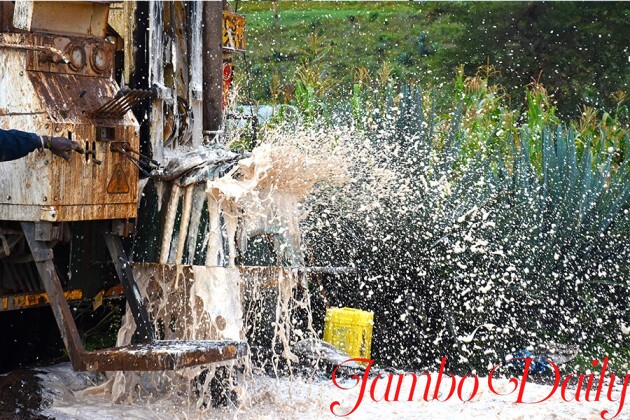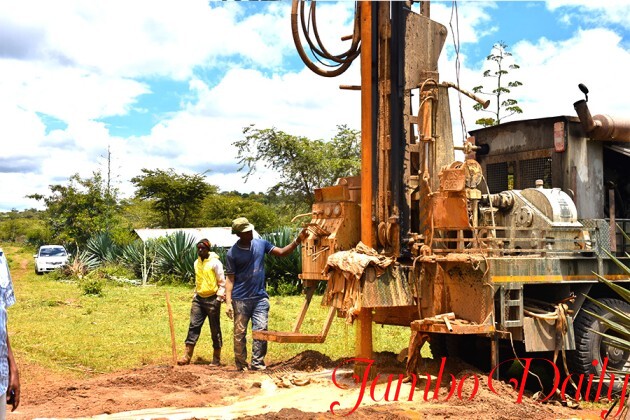
Borehole Drilling Requirements in Kenya
Borehole drilling is done in Kenya to meet the ever-increasing demand for water, primarily for domestic usage, irrigation, industrial, and livestock demands.
Borehole drilling in Kenya is mostly accomplished through the use of cutting-edge borehole drilling machines (also known commercially as borehole drilling rigs). Manual borehole drilling is also performed with manual digging tools.

Cost of Drilling Borehole in Kenya (Per meter per County)
| County | Cost (Min) | Cost (Max) |
| Nairobi | KES 6,500 | KES 9,500 |
| Kajiado | KES 6,500 | KES 9,500 |
| Machakos | KES 6,500 | KES 9,500 |
| Kitui | KES 6,600 | KES 9,500 |
| Makueni | KES 6,500 | KES 9,500 |
| Kiambu | KES 6,500 | KES 9,500 |
| Nakuru | KES 6,500 | KES 9,500 |
| Kisumu | KES 6,500 | KES 9,500 |
| Turkana | KES 8,000 | KES 9,500 |
| Bungoma | KES 6,500 | KES 9,500 |
| Busia | KES 7,700 | KES 9,500 |
| Narok | KES 6,800 | KES 9,500 |
| Mombasa | KES 7,000 | KES 9,500 |
| Kilifi | KES 7,500 | KES 9,500 |
| Kwale | KES 7,600 | KES 9,500 |
| Baringo | KES 6,900 | KES 9,500 |
| Siaya | KES 6,500 | KES 9,500 |
| Homabay | KES 6,500 | KES 9,500 |
| Uasin Gishu | KES 6,500 | KES 9,500 |
| Budalangi | KES 6,500 | KES. 12,000 |
Requirements for drilling a borehole in Kenya
The following items are required to dig a borehole in Kenya:

1. Hydrogeological Survey
This is done to estimate the potential for subsurface water. A hydrogeology survey report will estimate the drilling depth, site location, and the nature of rock and soil formation, which will help determine casing materials and drilling costs. This survey must be conducted by a qualified, impartial, and certified hydrogeologist. In Kenya, the cost of a hydrogeological survey ranges from Kes. 95,000 to Kes. 110,000, depending on location.
2. Permit from the WRA (Water Resource Authority).
The Water Resource Authority is a state-led organization that regulates the usage of all water resources. Once the hydrogeologist report is complete, they will issue a borehole drilling license and permit drilling.
To get licensed by the WRMA, you must fill out an application online or visit one of their offices situated across the country. WRA issues authorization licenses, which give the go-ahead to drill a borehole. They then offer you a water permit, which allows you to use the water resources as much as you wish.
3. Permit from NEMA (National Environment Management Authority)
This examines the environmental impact of drilling. The report details both the positive and bad environmental effects of drilling. They grant a green light permit if the project will not have negative environmental repercussions.
4. Environmenta Impact Assesment
This involves looking at how a project could affect the environment, detecting both good and bad consequences on the sorrouding area and community. This ensures apprpriate environmental management.
Drilling will begin once all of the above conditions are met.
Read also, List of Salty Water Lakes in Kenya
Kenya Borehole Drilling Procedure
1. Hydrogeological investigation
This is done to determine the soil formation, depth, and position of the actual drilling. It also aids in obtaining government clearances such as NEMA and WARMA certificates.
2. Drilling Itself
Actual drilling entails mobilizing a machine (drilling rig) and drilling. Drilling begins above ground and continues to the depth advised by the hydrogeologist. Casing is also done during drilling with steel or plastic casings. Borehole casing serves to keep the borehole from collapsing and keeps pollutants out of the borehole water.
3. Pumping Tests
After the drilling is finished, the borehole yield or capacity in m3 per hour (m3/hr) is determined by continually pumping water out of the borehole for 24 hours. Test pumping also aids in the selection of the best pump for the borehole.
4. Chemical analysis of water.
This is done to determine whether the borehole water is suitable for drinking, irrigation, or any other purpose. Some boreholes yield pure neutral water, whilst others create salty water that must be treated before consumption.
5. Borehole Equipping.
This includes installing pvc plastic casings and pumps. Depending on the expert’s advice, electric submersible, solar submersible, or diesel pumps may be fitted. Depending on the depth, the pipes immersed in the borehole may be uPVC or HDPE.
6. Auxilliary Services
This includes installing pvc plastic casings and pumps. Depending on the expert’s advice, electric submersible, solar submersible, or diesel pumps may be fitted. Depending on the depth, the pipes immersed in the borehole may be uPVC or HDPE.

Borehole drilling timelines
| Activity | Appox No of Days |
| Hydrogeological survey & report writing | 7 days |
| WRMA/NEMA Permits | 15-30 days |
| Actual Drilling | 4- 10 days |
| Equipping (Pump Installation) | 1-2 days |
Drilled water can be used for a variety of purposes, including:
- Water for domestic use
- Manufacturing
- Irrigation (mostly drip and sprinkler irrigation systems.
- Water can be collected and held in reservoirs with dam liners or pumped straight to farms.
- Use of livestock
- Institutions
- Recreational resources
Free borehole drilling in Kenya
Local and national governments provide free borehole drilling to communities in Kenya. In this form of agreement, the government pays service companies who then drill. Grekkon Limited is a business that provides affordable borehole drilling in Kenya.
